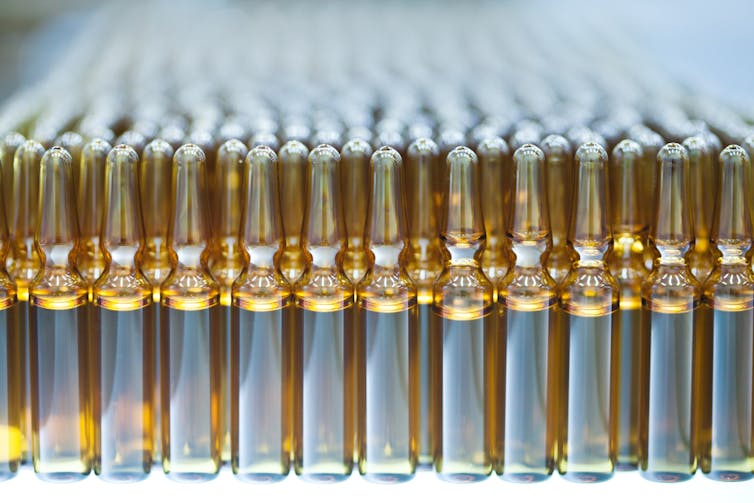
South Africa has been granted a licence to manufacture one of the world’s most important vaccines. It’s the first time the country will be able to do so since the mid 1990s, and is news that will result in many positive spin-offs for the country.
The hexavalent vaccine Hexaxim is used to vaccinate children against six life-threatening infectious diseases: diphtheria, tetanus, acellular pertussis (whooping cough), inactivated polio, Haemophilus influenza type b and hepatitis B. It is a vital component of South Africa’s expanded programme on immunisation and more than 3 million children are vaccinated every year. There are 14 vaccines administered between the ages of 0 and 2 years; four of these are Hexaxim. As a result of this programme, the number of children under the age of five that have died has significantly dropped. In 2013, it sat at 47 409 children, down from 89 418 in 2005.
In the late 1980s and early 1990s the country produced some of its own vaccines. But this capacity disappeared in the mid-1990s; the State Vaccine Institute and the South African Vaccine Producer, both run by the national health department, closed down because they weren’t operating at the required levels of manufacturing practice.
The department considered exiting vaccine manufacture entirely. But it was persuaded to enter into a partnership where a private company was mandated to upgrade the old State Vaccine Institute in exchange for a monopoly on vaccine supply. After years of negotiation and capacity building this partnership with – the Biovac Institute – has finally been given the go ahead. It will manage vaccine research and development, manufacturing and supply.
Local vaccine manufacture has several foreseeable benefits. These include decreased cost and increased availability and the capability to provide vaccines to the region. The local manufacturing process can also spur economic growth.
The cost factor
Manufacturing vaccines locally establishes a strategic capability in a sector which is prone to shortages and price fluctuations. These realities often have severe consequences for public health. For example earlier this year, newborns in South Africa could not be vaccinated against tuberculosis due to a shortage of the Bacillus Calmette-Guérin (BCG) vaccine.
Vaccines are supplied into a global market from a relatively small number of sites. Manufacturing problems, mostly linked to issues of quality and safety, do occur and not infrequently affect the supply of vaccines to lower value markets.
In South Africa the vaccines that form part of the extended programme on immunisation vaccines are a big budget item for the National and Provincial Departments of Health.
When the Biovac Institute was established the annual cost of vaccines was only R188 million. This cost has since grown to R1.75 billion. Hexaxim accounts for 37% of the expenditure. About 3 million doses of the vaccine are procured each year. These are imported directly by the Biovac Institute in single vials and then distributed to the clinics and hospitals.
Being able to manufacture these doses locally using imported antigens will enable Biovac to achieve, at least in part, one of its core objectives: to “ensure a domestic capacity in vaccine production that will enable the South African health authorities to respond to disease outbreak emergencies”. Over the medium term, local manufacture will also save an estimated 15% of the cost as compared to international procurement, depending on the actual vaccine and capacity utilisation of the manufacturing facility.
Local manufacture creates jobs, grows the economy and reduces the pressure on foreign exchange.
The details of the technology transfer agreement under which the institute will be making Hexacim are not yet publicly available. But it will be surprising if the deal does not allow South Africa to supply other countries in the Southern African Development Community and even sub-Saharan Africa with locally manufactured product. In this way it will be able to generate income.
A long time coming
Reaching this milestone has been a slow process. When the public private partnership was formed, it was thought that all of the core objectives would be reached within five years.
But the difficulties of building local skills, raising the finance and installing the infrastructure were under-estimated. Even the initial steps, which involved establishing sufficient absorptive capacity in the institute, took more time and expense that was originally anticipated.
The initiative had been costly for the public sector. Under the agreements of the partnership, the institute received a premium of about 13% on the wholesale price of the vaccine. This amounted to more than R1.1 billion between 2004 to 2016. These funds have been used to support the procurement, build the infrastructure, undertake research and development, and facilitate the technology transfer process.
Although this may seem a high price, a recent evaluation of the partnership showed that a positive value for money had been achieved. It argued that South Africa had not overpaid for its vaccines and that overall the institute had been of significant public benefit.
What it shows though is that public sector procurement is a powerful means of achieving local economic development. South Africa has not been very successful with this approach to date.
The institute’s achievement shows that such partnerships are possible. But it also shows that they require a long term commitment by both parties to resolve the problems and constraints which arise when the objectives are implemented.
![]() Although other means are possible, the institute supports this approach to localisation and suggests one strategy by which South Africa could reach its targets of economic growth and diversification.
Although other means are possible, the institute supports this approach to localisation and suggests one strategy by which South Africa could reach its targets of economic growth and diversification.
David Richard Walwyn, Professor of Technology Management, University of Pretoria

